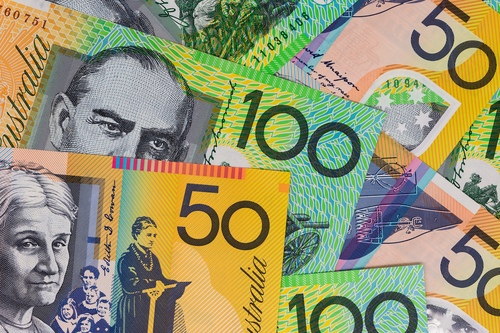AUD/USD finds support ahead of mid-0.6500s, not out of the woods yet amid bullish USD


- AUD/USD drops to its lowest level since August 8 amid the emergence of fresh USD buying.
- Bets for smaller Fed rate cuts and elevated US bond yields continue to underpin the buck.
- Traders now look to the US macro data ahead of the Australian CPI report on Wednesday.
The AUD/USD pair remains under some selling pressure for the third successive day on Tuesday and drops to its lowest level since August 8, closer to mid-0.6500s during the first half of the European session. The downward trajectory is sponsored by the emergence of fresh US Dollar (USD) buying, which remains well supported by expectations for a less aggressive policy easing by the Federal Reserve (Fed).
The incoming US macro data suggested that the economy remains on strong footing and boosted market expectations that the Fed will proceed with smaller interest rates over the year. Apart from this, concerns that the spending plans of Vice President Kamala Harris and the Republican nominee Donald Trump will further increase the deficit remain supportive of elevated US Treasury bond yields. This, in turn, assists the USD Index (DXY), which tracks the Greenback against a basket of currencies, to stall its retracement slide from a three-month peak touched on Monday and drags the AUD/USD pair lower.
Meanwhile, expectations that consumer inflation in Australia – due on Wednesday – will land at an annual rate of 2.9% for the September quarter, or the lowest since the March quarter of 2021, fuel speculations about an interest rate cut by the Reserve Bank of Australia (RBA). This turns out to be another factor undermining the Australian Dollar (AUD) and contributing to the offered tone surrounding the AUD/USD pair. The ongoing downfall could further be attributed to some technical selling following last week's breakdown below the 200-day Simple Moving Average (SMA) support near the 0.6630-0.6625 region.
The AUD, however, draws some support from reports that China is looking to approve the issuance of over ¥10 trillion in extra debt over the next few years in order to revive economic conditions as early as next week. Traders now look to Tuesday's US economic docket – featuring the Conference Board's Consumer Confidence Index and Job Openings and Labor Turnover Survey (JOLTS). Apart from this, the US bond yields and the broader risk sentiment will influence the USD. This might provide some impetus to the AUD/USD pair ahead of the Australian Consumer Price Index (CPI) report on Wednesday.
Economic Indicator
Consumer Price Index (QoQ)
The Consumer Price Index (CPI), released by the Australian Bureau of Statistics on a quarterly basis, measures the changes in the price of a fixed basket of goods and services acquired by household consumers. The CPI is a key indicator to measure inflation and changes in purchasing trends. The QoQ reading compares prices in the reference quarter to the previous quarter. A high reading is seen as bullish for the Australian Dollar (AUD), while a low reading is seen as bearish.
Read more.
Next release: Wed Oct 30, 2024 00:30
Frequency: Quarterly
Consensus: 0.3%
Previous: 1%
Source: Australian Bureau of Statistics
Why it matters to traders?
The quarterly Consumer Price Index (CPI) published by the Australian Bureau of Statistics (ABS) has a significant impact on the market and the AUD valuation. The gauge is closely watched by the Reserve Bank of Australia (RBA), in order to achieve its inflation mandate, which has major monetary policy implications. Rising consumer prices tend to be AUD bullish, as the RBA could hike interest rates to maintain its inflation target. The data is released nearly 25 days after the quarter ends.




